May 19, 2025 | 13:05 GMT +7
May 19, 2025 | 13:05 GMT +7
Hotline: 0913.378.918
May 19, 2025 | 13:05 GMT +7
Hotline: 0913.378.918
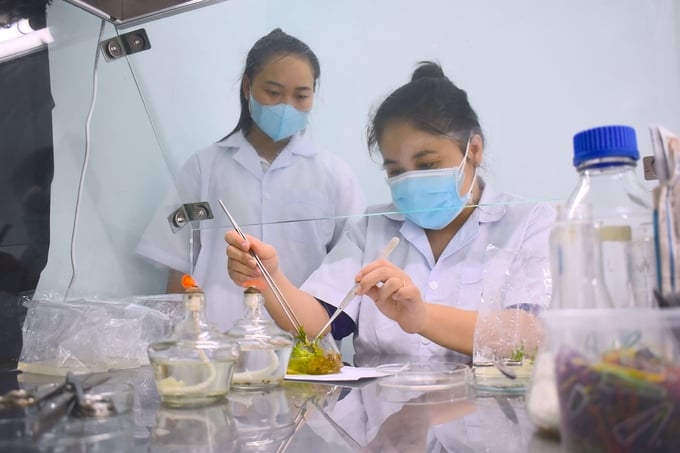
Ms. Bui Thi Kim Thanh (seated) performs the subculture step in tissue culture. Photo: Minh Dam.
Tissue culture has been an effective and growing breeding trend in recent years. This method applies cell technology to propagate new plants in an artificial environment, helping to quickly and simultaneously produce plant varieties while still completely retaining the characteristics of the original plant, while overcoming the disadvantages of other asexual propagation methods such as extraction, grafting or cuttings.
Over the past 4 years, Ms. Bui Thi Kim Thanh (born in 1992 in Binh Phan commune, Cho Gao district, Tien Giang province) has devoted herself to researching the process of propagating many types of plants using the tissue culture method. Currently, her 5Q Seedling - Tissue Culture Plant farm has successfully propagated over 30 types of plants such as MD2 pineapples, chrysanthemums, orchids ( Dendrobium) and many valuable ornamental plants.
Ms. Thanh and her husband, Mr. Ngo Hung Vu (born in 1993), are researchers working at the Department of Biotechnology, Physiology, Biochemistry and Postharvest at the Southern Horticultural Research Institute. In 2019, due to family circumstances, Ms. Thanh resigned from her work. But because of her passion for research, she and her husband gathered capital to open a plant breeding farm. Ms. Thanh's main task is to focus on researching the plant breeding process. And Mr. Vu, after his professional work hours at the Institute, will help his wife take care of the plants outside the greenhouse.

Prepare for transplanting roots. Photo: Minh Dam.
She said that in the first days of opening the facility, she encountered many difficulties and pressure because there are many plant varieties she had never researched before. She had to repeat experiments again and again to come up with a standard, stable process. Up to now, it has been more than 3 years, the investment costs for facilities and research on the tissue culture propagation process of Ms. Thanh and her husband have been more than VND 2 billion.
To obtain a complete seedling product using the tissue culture method, it is necessary to go through 3 stages. The first step is to find a source of disease-free, good-quality mother plants, then import and sterilize the samples. After that, we will create buds and multiply the number of buds. After the multiplication stage, they will be transplanted, separating each plant during the bud multiplication stage. Next is the rooting stage and finally some steps to prepare for taking the tree out of the nursery.
The steps of sterilizing samples, creating shoots, rapidly multiplying numbers, and transplanting roots are carried out in a tissue culture room (in vitro environment) over a long period of time from several months to more than 1 year. "Once you research the appropriate chemicals, concentrations, and time, the implementation will be very fast. At first, if you don't know or have never tried a certain variety, it will take more than a year to do many experiments," Ms. Thanh spoke.
She continued to explain that to sterilize the sample, she had to test many chemicals, test time, and carefully remember each operation to ensure the sample was disease-free, not infected with fungi, not infected with bacteria, and at the same time strongly live.
At the stage of creating buds, when multiplying the number, you still have to test the environment to add growth regulators with the appropriate concentration, not too little (tissue growth has a low number of buds), if the concentration is too high they will turn into scar tissue or mold.
At the rooting stage, there are simple plants like chrysanthemums that do not need to be supplemented with growth regulators and still have many roots, but there are many plants such as bamboo, orchids, and woody plants that are very difficult to root, so that growth regulators must be added at appropriate concentrations for roots to grow.
The final step is to take the tree to the nursery to gradually adapt to natural conditions. When bringing plants to the nursery, depending on the variety, there are plants that only need about 1.5 months of care before they can be planted, but there are also plants that take up to 3 months (like orchids) to be sold for the buyers.
From the time of rooting in the tissue culture room until being released into the greenhouse environment, depending on the type of plant, the survival rate ranges from 80% or more such as chrysanthemum (95%), life plant (95%), orchid (90%), gerbera daisies (80 - 90%)…
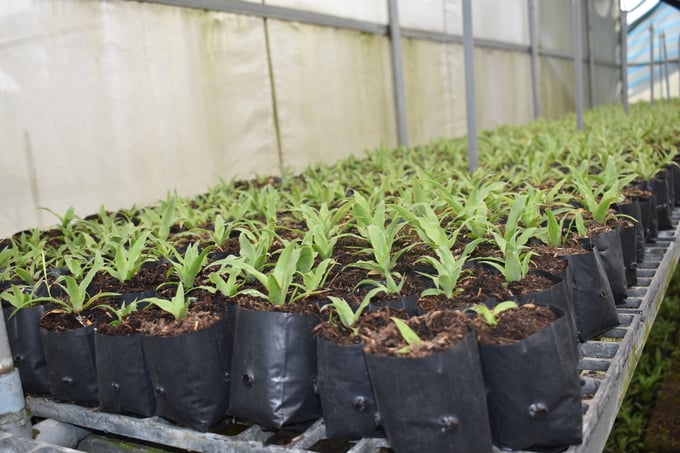
Pineapple is an important crop in Tan Phuoc district (Tien Giang province). Ms. Thanh's tissue culture pineapple variety has provided quality seedlings for this locality. Photo: Minh Dam.
According to Ms. Thanh, tissue culture seedlings have three advantages that people are interested in choosing: standard varieties, disease-free, and creating large yields with uniform quality. Previously, local farmers, especially ornamental flower farmers in My Tho City, did not have access to a reputable source of disease-free tissue culture seedlings. That motivated her to start a business with the knowledge and experience she had been trained and cultivated during her time working as a scientist with the desire to bring value to society through reducing production costs and providing prestigious and quality products for farmers.
By taking advantage of the available space of the family, the selling price of the product is calculated close to the production cost to create conditions for people to have better access to quality seedlings at affordable prices.
Her products are highly trusted by local farmers because of their good quality and lower prices than similar products on the market. For example, for gerbera chrysanthemums, products supplied from Da Lat City to Tien Giang have a selling price of about VND 5,500 - 6,000/plant, at her facility the selling price is only VND 4,000 - 4,500/plant. Or like the life plant that many places sell for about VND 4,000/tree, at this facility, it's only VND 3,000/tree...
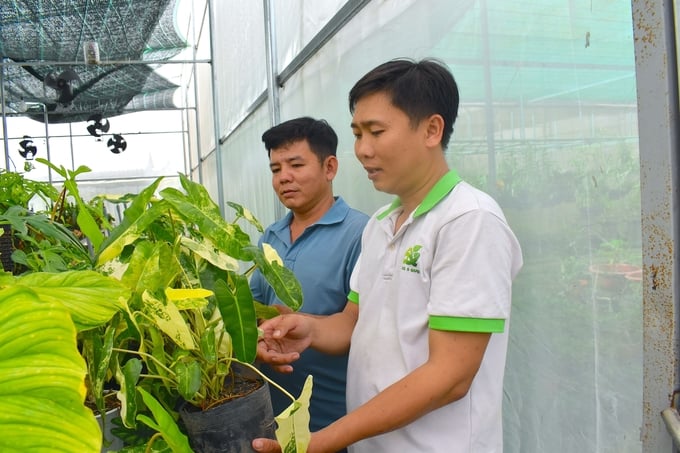
Mr. Ngo Hung Vu (white shirt) is in charge of taking care of ornamental plants outside the net house. Photo: Minh Dam.
Currently, the farm of the 9X female engineer and her husband has provided regular jobs for 4 workers with an income of VND 5 million/person/month. These are young workers with the same passion for scientific research. In addition, there are many irregular jobs with income ranging from VND 200,000/female worker to VND 350,000/male worker.
“My wife and I guide young people to develop together. In addition to salary, I also give bonuses to those who work here after each shipment. I also hope the facility will create more jobs for local farmers," said Mr. Ngo Hung Vu.
After 4 years of research, this year Ms. Thanh officially released tens of thousands of tissue culture seedlings of all kinds. Her goal in the coming years will be to increase output from 300 - 400 thousand/tree/year. In addition, the 5Q Seedling - Tissue Culture Plant facility of Ms. Thanh and Mr. Vu couple intends to actively perfect tissue culture products of Dendrobium orchid varieties, MD2 pineapples and some ornamental leaves to participate in the voting, evaluating and classifying OCOP products.
Along with that, this facility intends to cooperate with local farmers to develop according to the collective economic model to increase production output.
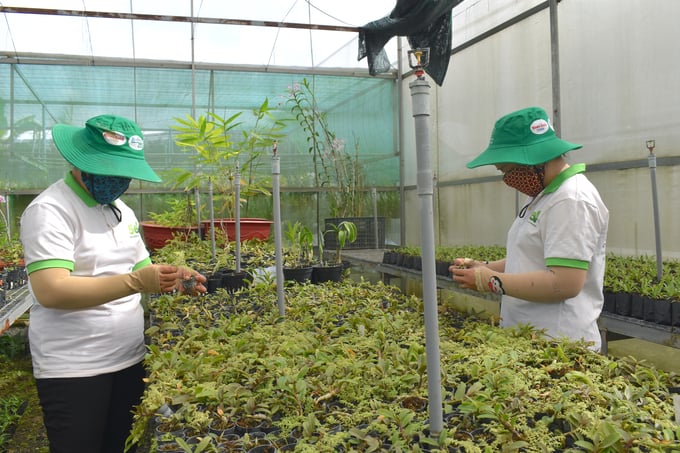
Many workers have jobs thanks to the young couple's experimental model. Photo: Minh Dam.
"Our facility will produce seedlings, members with large land will take care of them according to the facility's instructions, then we will purchase the seedlings for them to sell to the market," Mr. Vu said about the upcoming development direction.
The tissue culture seedling production model of Ms. Thanh and Mr. Vu not only provides people with quality seedlings at affordable prices, but also contributes to promoting production, reducing costs, and increasing profits for the farmers, but also help them change their perception in developing agriculture towards modernity and high technology.
Translated by Bao Ngoc
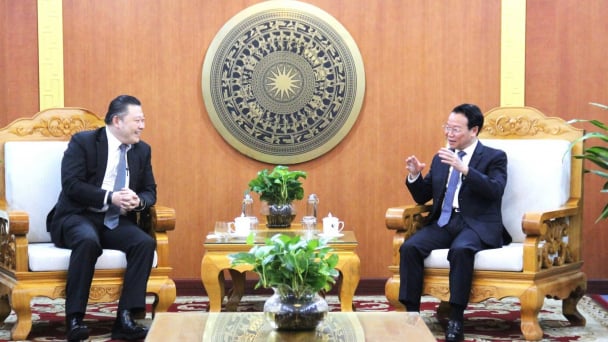
(VAN) Minister of Agriculture and Environment Do Duc Duy held a meeting with Soopakij Chearavanont, Chairman of C.P. Group, on May 15.
/2025/05/16/3800-0-nongnghiep-143756.jpg)
(VAN) Suntory PepsiCo Vietnam coordinated with the Ministry of Education and Training to implement an education program on water conservation, reaching nearly 1 million primary school students nationwide.
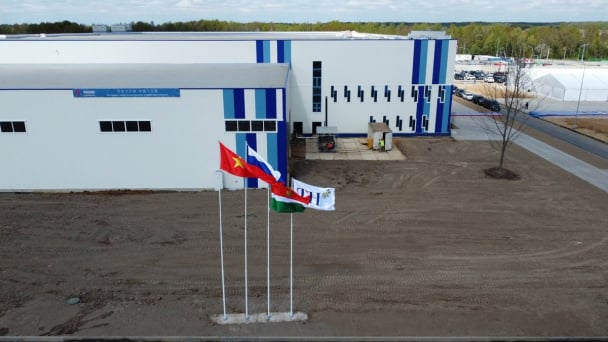
(VAN) Vietnam’s TH Group officially put its high-tech fresh milk processing plant into operation in the Russian Federation, marking a historic moment as the first TH true MILK cartons were produced in Russia.

(VAN) Use of high-quality broodstock and biotechnology is regarded as the most effective approach to ensuring sustainable and economically viable shrimp aquaculture ahead of climate change and the emergence of increasingly intricate disease patterns.
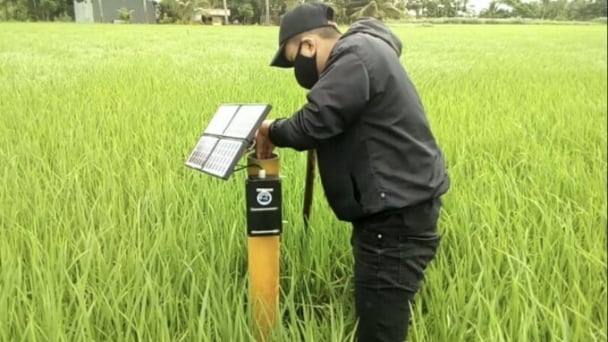
(VAN) Carbon farming is a form of agricultural practices that helps absorb more greenhouse gases than it emits, through smart management of soil, crops, and livestock.
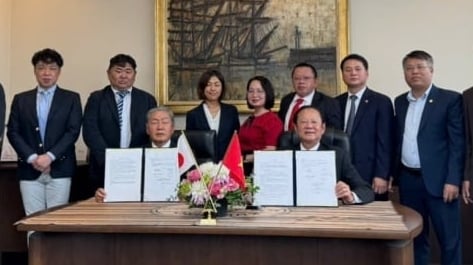
(VAN) This is a key content of the Memorandum of Understanding recently signed between the Vietnam Fisheries Society and Kunihiro Inc of Japan.
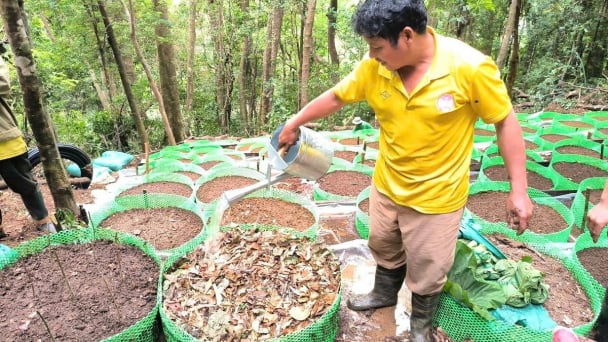
(VAN) To achieve the goal, local authorities and businesses in Kon Tum province have fully prepared the necessary conditions for the new Ngoc Linh ginseng planting season.